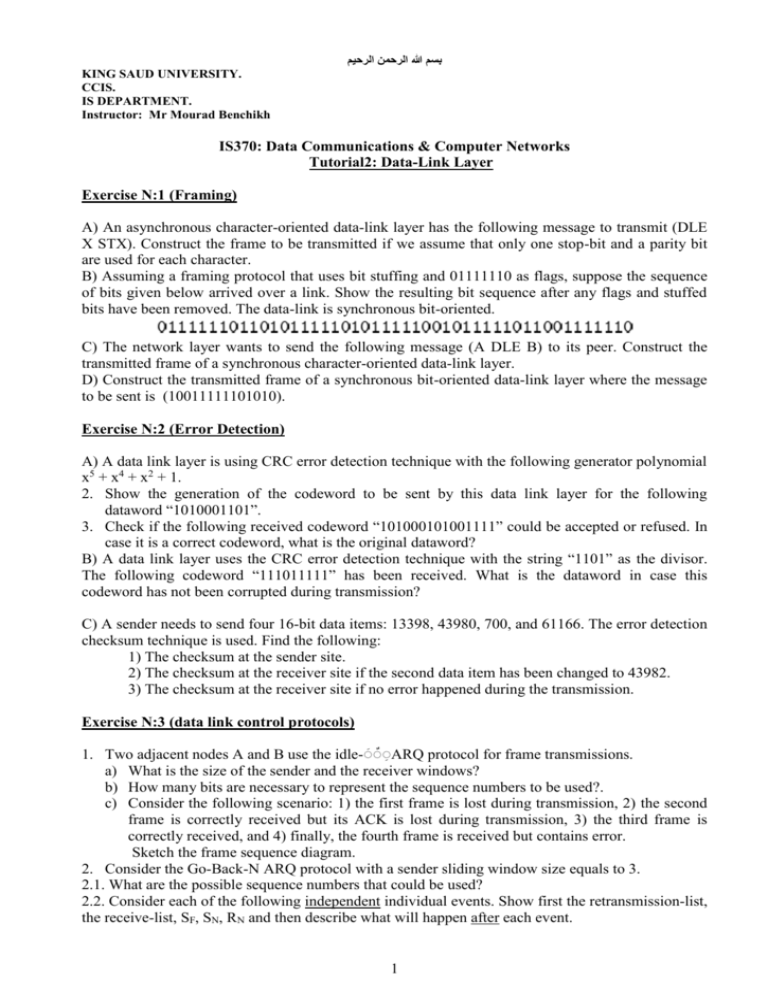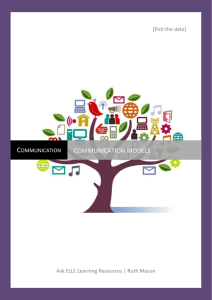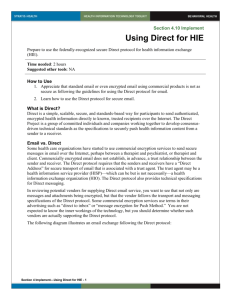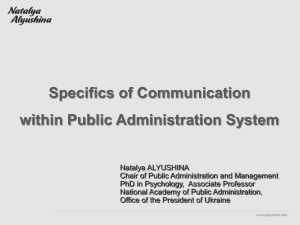Exercise N:2
advertisement

بسم هللا الرحمن الرحيم KING SAUD UNIVERSITY. CCIS. IS DEPARTMENT. Instructor: Mr Mourad Benchikh IS370: Data Communications & Computer Networks Tutorial2: Data-Link Layer Exercise N:1 (Framing) A) An asynchronous character-oriented data-link layer has the following message to transmit (DLE X STX). Construct the frame to be transmitted if we assume that only one stop-bit and a parity bit are used for each character. B) Assuming a framing protocol that uses bit stuffing and 01111110 as flags, suppose the sequence of bits given below arrived over a link. Show the resulting bit sequence after any flags and stuffed bits have been removed. The data-link is synchronous bit-oriented. C) The network layer wants to send the following message (A DLE B) to its peer. Construct the transmitted frame of a synchronous character-oriented data-link layer. D) Construct the transmitted frame of a synchronous bit-oriented data-link layer where the message to be sent is (10011111101010). Exercise N:2 (Error Detection) A) A data link layer is using CRC error detection technique with the following generator polynomial x5 + x4 + x2 + 1. 2. Show the generation of the codeword to be sent by this data link layer for the following dataword “1010001101”. 3. Check if the following received codeword “101000101001111” could be accepted or refused. In case it is a correct codeword, what is the original dataword? B) A data link layer uses the CRC error detection technique with the string “1101” as the divisor. The following codeword “111011111” has been received. What is the dataword in case this codeword has not been corrupted during transmission? C) A sender needs to send four 16-bit data items: 13398, 43980, 700, and 61166. The error detection checksum technique is used. Find the following: 1) The checksum at the sender site. 2) The checksum at the receiver site if the second data item has been changed to 43982. 3) The checksum at the receiver site if no error happened during the transmission. Exercise N:3 (data link control protocols) 1. Two adjacent nodes A and B use the idle-ِِِARQ protocol for frame transmissions. a) What is the size of the sender and the receiver windows? b) How many bits are necessary to represent the sequence numbers to be used?. c) Consider the following scenario: 1) the first frame is lost during transmission, 2) the second frame is correctly received but its ACK is lost during transmission, 3) the third frame is correctly received, and 4) finally, the fourth frame is received but contains error. Sketch the frame sequence diagram. 2. Consider the Go-Back-N ARQ protocol with a sender sliding window size equals to 3. 2.1. What are the possible sequence numbers that could be used? 2.2. Consider each of the following independent individual events. Show first the retransmission-list, the receive-list, SF, SN, RN and then describe what will happen after each event. 1 a) The sender, having only two frames, sends them to the receiver which receives them without error. The receiver sends only one acknowledgment to acknowledge the two received frame. b) The network layer of the sender has always data to send. F(0), F(1), and F(2) have been sent by the sender’s data link layer. F(0) and F(1) are safely received however F(2) is received with errors. The first acknowledgment is lost and the second one arrives before the timer expiration. c) A sender, with many frames to send, sends as many frames as it can. The receiver receives correctly all the sent frames however all the sent ACKs are lost or corrupted except ACK(3). 3. Two adjacent nodes use the Selective-Repeat ARQ protocol. We assume that the sliding receiver window size is equal to 4. a) Write down the sequence numbers that can be used by each frame/ACK/NAK and how many bits are necessary to represent them? b) Consider the successive following events. Show first the retransmission-list, the receive-list, SF, SN, RN and then describe what will happen for each event. 1. The initial state, i.e. no frame has been sent. 2. The sender sends as many frames as it can. All these frames are correctly received by the receiver except F(2) which is received with errors. ACK(1) is received by the sender while ACK(2) is lost. No timer has expired. 3. The sender resumes its emission process and the first subsequent frame sent is lost. Exercise N:4 (Multiple access: CSMA/CD) 1. Find the minimum frame size allowing the correct operation of the collision detection process with a CSMA/CD network having a data rate of 10Mbps and a maximum distance of 5120m and a propagation speed of 2*108m/s (ignoring the delay times in repeaters and interfaces and the time required to send jam sequence). 2. What is the minimum frame size in the same network if the data rate is 100Mbps? 3- Consider the same network described in 1). Two stations, A and B belong to this network, are separated by 3000m. Station A starts sending at time t=1s. 3.1) when the station B decides to send a frame at t=4s, does its carrier sensing process allow it to send? 3.2) when the two stations will hear the collision? 3.3) compute the number of bits send by the two stations prior to the collision. 3.4) If the actual collision is the 4th consecutive one for the station A. What station A will do? Exercise N:5 (Ethernet) 1) Find the 6-byte hexadecimal notation of the following destination Ethernet address. Note that this address bit configuration corresponds to the one put on the line (not to the written one)? Define the type of this destination address. 11001110 01000000 10001101 01110100 00000001 11101111 2) Define the type of this destination address Exercise N:6 (Connecting LANs: bridge) I) Consider a transparent bridge connecting three LANs. The bridge’s table is initially empty. 1) Describe the forwarding and the learning processes carried by the bridge after each of the following frame transmission. 2 o o o o P sends a frame to M. N sends a frame to L. Q sends a frame to O. M sends a frame to N 2) Show the bridge’s table content after each station has sent a frame to another stations 3) Describe what will happen when P sends a frame to Q -assuming that the bridge’s table is completely filled-. II) Consider the following internetwork where seven transparent bridges connect seven LANs. 1) Describe what will happen when Station1 sends a frame to station5. 2) Describe how the transparent bridge will resolve the problem encountered in the previous case. III) Create an internetwork with four LANs and four bridges. The bridges connect the LANs as follows. a) B4 connects LAN 2 and LAN 4 respectively on ports 1 and 2. b) B3 connects LAN 2, LAN 3, and LAN 4 respectively on ports 1, 2, and 3. c) B2 connects LAN 1 and LAN 3 respectively on ports 1 and 2. d) B1 connects LAN 1 and LAN 2 respectively on ports 1 and 2. 1. Draw the resulting internetwork. 2. Find the spanning tree where B1 is the root bridge. 3. Show the resulting forwarding and the blocking ports 3







